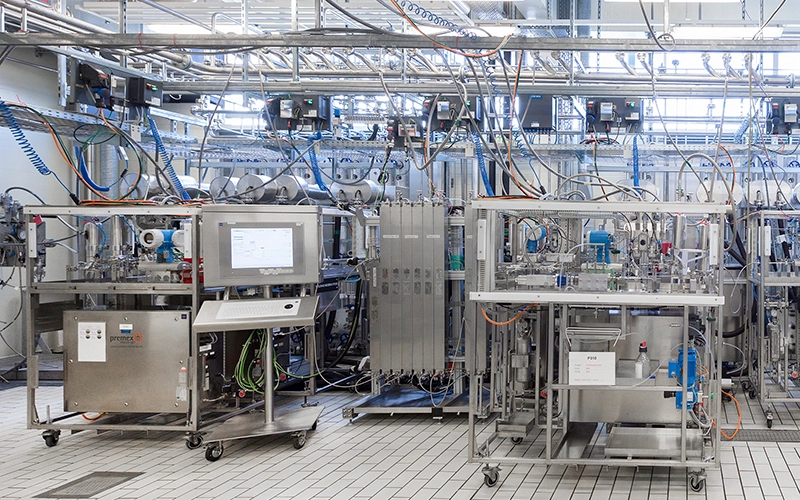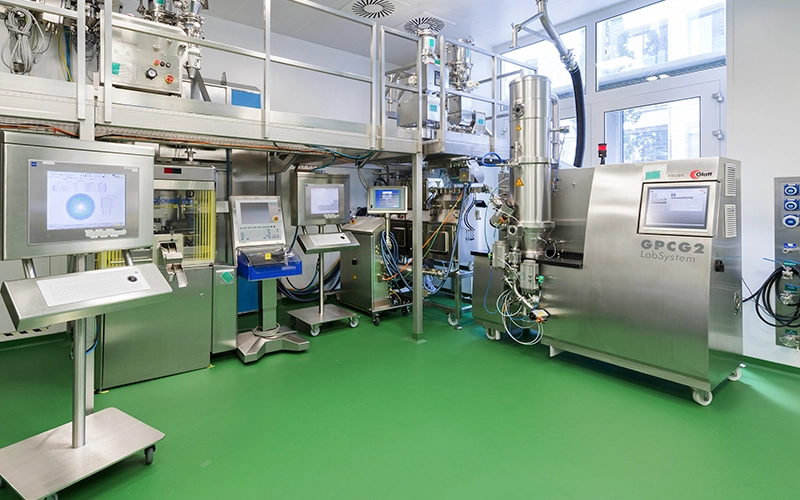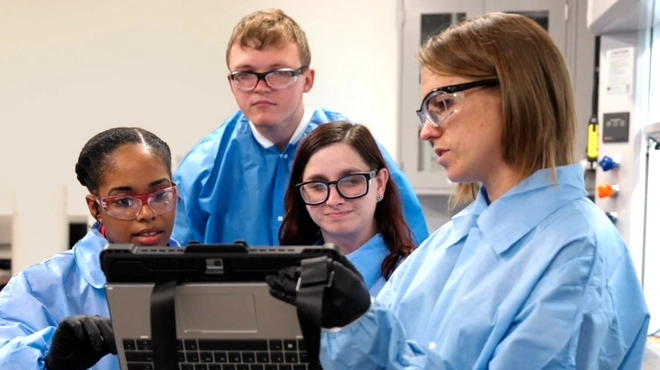Most medicines are made the old-fashioned way. In fact, the process hasn’t changed much for over a hundred years. Engineers mix large amounts of chemical materials together in industrial-sized vats, the way a baker might make a very large batch of cookies.
It’s a reliable system, but not very flexible.
Recent advances in chemical engineering and automation, however, have ushered in a new era for pharmaceutical manufacturing. Today the industry is beginning to introduce a new method called continuous flow manufacturing, which flows small amounts of chemical ingredients through a streamlined process that operates without disruption all the way from raw ingredient to tablet.
Continuous flow manufacturing changes the way drugs are made, and it also influences the way chemists dream them up in the earliest stages of drug discovery. The miniaturized technology opens up a realm of possible chemical combinations that were prohibited before because the chemical reactions required to make them were too volatile, wasteful, toxic or slow.
“Continuous flow techniques give you access to chemical reactions that are highly dangerous in the batch world,” says Markus Krumme, Head of the Continuous Manufacturing unit at Novartis. “In the long run, we believe this expanded chemical space will give chemists a chance to find compounds that would have been very difficult to find before.”
This change in operations was made possible by the efforts of engineers and scientists at the Novartis-MIT Center for Continuous Manufacturing, an alliance formed a decade ago and supported by Novartis. Continuous manufacturing in the pharmaceutical industry has the potential to cut drug manufacturing time by 90% and drug manufacturing costs by 30-50%.
Novartis opened its first continuous flow manufacturing facility in Basel, Switzerland, last year.
More creative chemistry
Medicinal chemists like Hansjoerg Lehmann invent compounds – chemical structures designed to interfere with a biological process that drives disease. To visualize a compound, chemists sometimes build plastic models, snapping together differently shaped puzzle pieces into 3-D shapes.
But unlike plastic puzzle pieces, chemicals don’t snap together; they join through chemical reactions. Some reactions are easy to perform. “Other reactions are more difficult to handle,” says Lehmann, who is part of the Global Discovery Chemistry group at the Novartis Institutes for BioMedical Research (NIBR). “Medicinal chemists tend to routinely use robust reactions, not capricious ones.”
By limiting the range of chemical reactions used, chemists also limit the range of compounds they can create. But over the past decade, chemical engineers at the Novartis-MIT Center developed continuous flow manufacturing tools that miniaturize the reactors chemicals combine in. These tools provide chemists with ways to handle more types of chemical reactions safely and with confidence.


For instance, a chemist might apply light to a chemical to cause a reaction, something that is possible to do reliably in a small tube of chemicals but is impossible to do in a large vat. The center of the vat would remain dark, while the edges would be over exposed.
Potentially explosive reactions can also be performed safely. The amount of material in a reaction at any time is small enough to minimize danger. Further, the reaction can be monitored and controlled so that it does not accumulate enough energy to become dangerous. “The point is that chemists have more choices of reagents and reaction conditions when performing flow chemistry,” says Klavs Jensen, the Warren K. Lewis professor of chemical engineering at the Massachusetts Institute of Technology (MIT) in the US. “It allows more creativity. If you have more flexibility to manipulate the chemistry, you can create a wider variety of compounds.”
Smarter chemistry
Continuous manufacturing tools also change the process of figuring out how to scale a chemical recipe up from the home kitchen of the chemist’s laboratory bench to the manufacturing facility. Not all small-scale recipes translate, and in fact, some shouldn’t even be attempted in a large facility.
For instance, some reactions proceed too slowly or don’t produce enough of the end product given the amount of material used. In some cases, though, a recipe that looks untenable can be altered to be more productive, to cause a faster reaction, or even to use less toxic starting materials.
This kind of optimization has been done by chemists, painstakingly, one reaction at a time. With continuous flow tools, however, the process can be automated. The chemist begins by setting up a miniaturized version of a flow of chemicals through reactors, and then links that flow to sensors that monitor important variables, such as reaction times or yield. Those measures are fed into a computer that then adjusts inputs, such as material amounts or heat, and that runs the reaction again – repeating the process over and over until it finds the best possible recipe.
Engineers at MIT are now at work building tools such as these that self-optimize reactions. “We can learn much more about a reaction than before,” says Lehmann. “This is really a smart thing and will save us time in the end.”
Main image: A look inside the continuous flow manufacturing facility Novartis opened in Basel, Switzerland. Image by Tanja Devald/Novartis.
A new pharma manufacturing method could change #drugdiscovery. Find out how.



